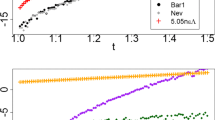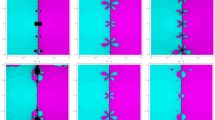Abstract
Diagonally implicit Runge-Kutta methods satisfying additional order conditions are examined. These conditions make it possible to solve differential algebraic equations of indices two and three to higher accuracy. Advantages of the proposed methods over other known techniques are demonstrated using test problems.
Similar content being viewed by others
References
E. Hairer and G. Wanner, Solving Ordinary Differential Equations II: Stiff and Differential-Algebraic Problems (Springer-Verlag, Berlin, 1996; Mir, Moscow, 1999).
R. Alexander, “Diagonally Implicit Runge-Kutta Methods for Stiff ODEs,” SIAM J. Numer. Anal. 14, 1006–1021 (1977).
F. Cameron, M. Palmroth, and R. Piche, “Quasi Stage Order Conditions for SDIRK Methods,” Appl. Numer. Math. 42 (1–3), 61–75 (2002).
F. Cameron, “A Class of Low Order DIRK Methods for a Class of DAE,” Appl. Numer. Math. 31 (1), 1–16 (1999).
R. Williams, K. Burrage, I. Cameron, and M. Kerr, “A Four-Stage Index 2 Diagonally Implicit Runge-Kutta Method,” Appl. Numer. Math. 40, 415–432 (2002).
L. M. Skvortsov, “Diagonally Implicit Runge-Kutta FSAL-Methods for Stiff and Differential-Algebraic Systems,” Mat. Model. 14 (2), 3–17 (2002).
L. M. Skvortsov, “Accuracy of Runge-Kutta Methods Applied to Stiff Problems,” Zh. Vychisl. Mat. Mat. Fiz. 43, 1374–1384 (2003) [Comput. Math. Math. Phys. 43, 1320-1330 (2003)].
A. Kværnø, “Singly Diagonally Implicit Runge-Kutta Methods with an Explicit First Stage,” BIT 44, 489–502 (2004).
L. M. Skvortsov, “Diagonally Implicit Runge-Kutta Methods for Stiff Problems,” Zh. Vychisl. Mat. Mat. Fiz. 46, 2209–2222 (2006) [Comput. Math. Math. Phys. 46, 2110-2123 (2006)].
E. Hairer, Ch. Lubich, and M. Roche, The Numerical Solution of Differential-Algebraic Systems by Runge-Kutta Methods (Springer-Verlag, Berlin, 1989).
L. Jay, “Convergence of a Class of Runge-Kutta Methods for Differential-Algebraic Systems of Index 2,” BIT 33, 137–150 (1993).
L. Jay, “Convergence of Runge-Kutta Methods for Differential-Algebraic Systems of Index 3,” Appl. Numer. Math. 17 (2), 97–118 (1995).
E. Hairer, S. P. Nörsett, and G. Wanner, Solving Ordinary Differential Equations. I: Nonstiff Problems (Springer-Verlag, Berlin, 1987; Mir, Moscow, 1990).
J. C. Butcher, Numerical Methods for Ordinary Differential Equations (Wiley, Chichester, 2003).
D. S. Guzhev and N. N. Kalitkin, “Optimal Scheme for the ODE Solver ROS4,” Mat. Model. 6 (11), 128–138 (1994).
O. S. Kozlov, L. M. Skvortsov, and V. V. Khodakovskii,, “Solution of Differential and Differential-Algebraic Equations in the Software Package MVTU,” http://model.exponenta.ru/mvtu/20051121.html.
Author information
Authors and Affiliations
Corresponding author
Additional information
Original Russian Text © L.M. Skvortsov, 2010, published in Zhurnal Vychislitel’noi Matematiki i Matematicheskoi Fiziki, 2010, Vol. 50, No. 6, pp. 1047–1059.
Rights and permissions
About this article
Cite this article
Skvortsov, L.M. Diagonally implicit Runge—Kutta methods for differential algebraic equations of indices two and three. Comput. Math. and Math. Phys. 50, 993–1005 (2010). https://doi.org/10.1134/S0965542510060072
Received:
Published:
Issue Date:
DOI: https://doi.org/10.1134/S0965542510060072




